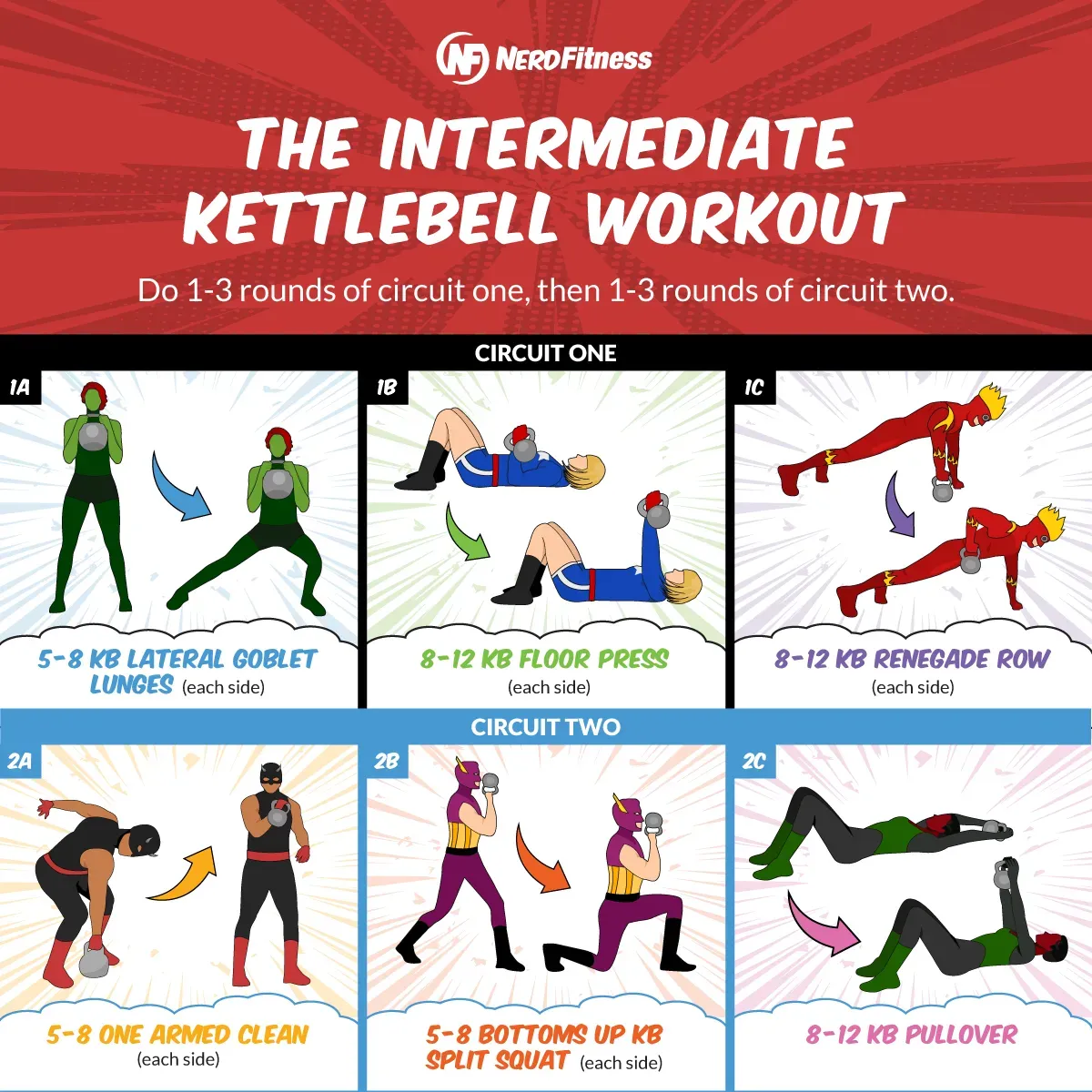Table of Contents
Feeling a bit intimidated by kettlebells? You're not alone. Lots of women look at those cast iron weights and think, "Where do I even start?" Maybe you've seen people swinging them around at the gym or online and wondered if it's something you could do. The good news is, a kettlebell is an incredibly effective tool for building strength, burning fat, and improving your overall fitness, and it's absolutely accessible even if you've never touched one before. This article is specifically designed to guide the **kettlebell workout female beginner**. We'll cut through the confusion and show you exactly why kettlebells are worth your time, how to pick the right one, and walk you through a simple, effective first routine. We'll also cover key safety tips so you can feel confident and get results. Ready to ditch the guesswork and start swinging your way to a stronger you?
Why a Kettlebell Workout is Perfect for a Female Beginner

Why a Kettlebell Workout is Perfect for a Female Beginner
Gets the Whole Body Working at Once
Look, nobody has unlimited time. If you're trying to juggle work, life, maybe kids, spending an hour on the elliptical and then another hour lifting separate muscle groups sounds less like a workout plan and more like a second job. This is where the magic of a kettlebell starts for a **kettlebell workout female beginner**. Unlike dumbbells or barbells where you often isolate muscles, kettlebell movements, especially the foundational ones like the swing, clean, and squat, demand coordination and power from multiple muscle groups simultaneously. Think legs, glutes, core, back, and shoulders – all firing together. It’s efficient, effective, and frankly, way less boring than doing endless bicep curls.
Builds Real-World Strength and Power
Forget just looking good in the mirror. Kettlebells build functional strength – the kind that makes carrying groceries easier, helps you lift that heavy box without throwing out your back, or gives you the power to keep up with energetic kids (or pets). The dynamic nature of kettlebell exercises, particularly the ballistic movements like swings, teaches your body to generate power quickly and explosively. This isn't just about lifting heavy things slowly; it's about controlling momentum and using your entire body as a single, powerful unit. That kind of strength translates directly into everyday life, making you feel more capable and resilient.
- **Time Saver:** Hits multiple muscle groups fast.
- **Functional Power:** Builds strength you can actually use.
- **Metabolic Boost:** Burns serious calories during and after.
- **Core Crusher:** Works your abs and back harder than you think.
- **Joint Friendly (when done right):** Improves mobility and stability.
You Don't Need a Gym Full of Equipment
One of the biggest hurdles for starting any fitness routine is often access to equipment or a gym. With a kettlebell, that problem largely disappears. You need just one kettlebell and enough space to swing your arms safely. That's it. You can get a killer workout in your living room, garage, backyard, or even a small corner of an apartment. This portability and minimal equipment requirement makes it incredibly convenient for a **kettlebell workout female beginner** who might not be ready for a gym membership or simply prefers working out at home. It removes a major excuse right off the bat.
Picking Your First Kettlebell and Learning the Basics

Picking Your First Kettlebell and Learning the Basics
How Heavy Should This Thing Be?
Alright, let's talk weight. This is where a lot of beginners freeze up. You don't want something too light that feels like you're swinging a purse, but you definitely don't want something so heavy you risk launching it through your drywall. For most women just starting out with a kettlebell workout, especially focusing on foundational movements like the swing, a good starting point is often an 8kg (around 18 lbs) or 12kg (around 26 lbs) kettlebell. If you're feeling pretty strong already from other training, maybe lean towards the 12kg. If you're completely new to lifting anything heavier than a gallon of milk, start with the 8kg. You can always go up later. Trust me, an 8kg kettlebell swing done correctly for reps will still make you feel it.
Grip it Like You Mean It (But Not Too Hard) and Find Your Feet
Once you've got your kettlebell, let's talk about how you actually hold it and where you stand. For most exercises, you'll use a "hook grip" or a relaxed grip where the handle sits in the crook of your fingers, not deep in your palm. This prevents blisters and allows the bell to move freely. Your stance for swings and other lower body movements should be about shoulder-width or slightly wider, with your toes pointed slightly out. Think athletic stance – ready to jump. Your knees should track over your toes, and your weight should be balanced, maybe slightly more towards your heels. This isn't rocket science, but getting the basic setup right prevents a lot of headaches later.
- **Starting Kettlebell Weights for Female Beginners:**
- If new to lifting: 8kg (approx 18 lbs)
- If some lifting experience: 12kg (approx 26 lbs)
- Consider your goals: Lighter for presses/overhead, heavier for swings/deadlifts.
- Don't buy too many too soon; master one weight first.
Master the Hip Hinge Before You Swing
This is arguably the single most important concept for any effective and safe kettlebell workout, especially for a female beginner. The hip hinge is NOT a squat. A squat looks like sitting in a chair. A hip hinge looks like bowing or touching your toes while keeping your back straight. You're pushing your hips back, maintaining a neutral spine, and feeling the stretch in your hamstrings. Your knees will bend, but the primary movement comes from the hips. Practice this first without a kettlebell, then with the bell held lightly in front of you. If you can't hinge properly, your kettlebell swings will look less like powerful movements and more like awkward attempts to lift something with your back – which is a fast track to pain. Get this right, and everything else becomes much easier.
Your First Kettlebell Workout for Female Beginners: A Simple Routine

Your First Kettlebell Workout for Female Beginners: A Simple Routine
Starting Simple: Why Less is More
you've got your kettlebell, you know how to hinge, and you're ready to actually *do* something with it. Don't feel like you need to jump into complex juggling or intricate flows right away. The goal for your first few sessions is to build confidence and solid form on a couple of key movements. Trying to do too much too soon is the fastest way to get frustrated or, worse, injured. A simple routine focusing on just two or three exercises, done well, will give you incredible results and set you up for long-term success. Think of it as building a strong foundation before you start adding extra floors to the building.
The Non-Negotiable First Move: The Kettlebell Swing
If there's one exercise that defines kettlebell training and is essential for any **kettlebell workout female beginner**, it's the two-handed swing. This isn't an arm exercise; it's a powerful hip-driven movement. Stand over the bell, hinge at your hips, grab the handle, and hike it back between your legs like you're snapping a football. Then, *powerfully* and *explosively* extend your hips, using that force to drive the kettlebell forward and up to chest height. Your arms are just ropes guiding the bell. Control the descent as it falls back between your legs, hinging again. Aim for tight, powerful hip snaps, not lifting with your shoulders. It should feel like a dynamic hinge, not an awkward front raise.
Here’s a simple starting point for swings:
- Set 1: 10 reps (focus on form, not speed)
- Set 2: 12 reps
- Set 3: 15 reps
Rest 60-90 seconds between sets. If your back feels it more than your glutes and hamstrings, stop. Review your hip hinge.
Adding a Strength Staple: The Goblet Squat
Once you feel comfortable with the swing, adding a strength movement like the goblet squat is a smart next step for your **kettlebell workout female beginner** routine. Hold the kettlebell by the horns (the sides of the handle) against your chest. Stand with your feet about shoulder-width apart, maybe slightly wider, toes pointed slightly out. Keeping your chest tall and your back straight (like you practiced with the hinge), squat down as if sitting between your knees. Go as low as you can comfortably while keeping your heels on the ground and your back neutral. Drive through your heels to stand back up, squeezing your glutes at the top. This move is fantastic for hitting your quads, glutes, and core.
Try this after your swings:
Set | Reps | Focus |
|---|---|---|
1 | 8-10 | Controlled descent, chest up |
2 | 10-12 | Maintain depth and form |
3 | 12-15 | Push through heels, squeeze glutes |
Rest 60 seconds between sets. This simple combo of swings and goblet squats is a potent full-body punch.
Avoiding Common Mistakes and Staying Safe

Avoiding Common Mistakes and Staying Safe
Swinging With Your Arms, Not Your Hips (The Number One Sin)
This is the most common error I see, hands down. A **kettlebell workout female beginner** often treats the swing like a front raise or an arm exercise. They lift the bell up using their shoulders and arms, letting the kettlebell float away from their body at the top. This is not only ineffective – you miss out on the massive power and calorie burn from your hips – but it's also a great way to strain your back and shoulders. Remember that hip hinge we talked about? The swing is just an explosive version of that. Your hips and glutes are the engine, driving the bell forward. Your arms are just cables holding on for the ride. Keep the bell close to your body on the backswing, power it up with your hips, and let it float momentarily at chest height, controlled by your core, not lifted by your arms.
Ignoring Pain and Rushing Progress
It's tempting to see others doing heavier swings or more complex moves and want to jump ahead. Don't. Your body needs time to adapt to the unique demands of kettlebell training. Pushing through sharp pain is foolish; learn the difference between muscle fatigue and joint distress. If something feels wrong, stop. Re-check your form. Maybe drop to a lighter weight or even practice the movement without the bell. Think of it like learning to drive stick shift – you'll stall a few times, maybe grind the gears, but you wouldn't immediately try to race on a highway. Master the basics with a weight you can control for sets of 10-15 reps *with good form* before adding weight or complexity. Consistency and proper form trump speed and heavy weight every single time for a **kettlebell workout female beginner** looking for sustainable results.
- **Common Mistakes to Avoid:**
- Lifting with arms in swings (use hips!)
- Rounding your back (maintain a neutral spine)
- Squatting the swing (it's a hinge!)
- Using a weight that's too heavy too soon
- Not controlling the bell on the eccentric (downward) phase
- Holding the grip too tightly (causes blisters)
Ready to Swing? Your Kettlebell Beginning
So there you have it. Starting a kettlebell workout as a female beginner isn't some mythical feat reserved for gym gurus. It's about picking a manageable weight, learning a few fundamental moves, and giving it a consistent shot. We've covered why these rusty cannonballs are effective, how to get your hands on the right one, and a straightforward routine to get you moving. Don't overthink it. The biggest hurdle is usually just starting. Grab that kettlebell, find a little space, and see what you can do. Progress happens with practice, not procrastination. Now go swing something.